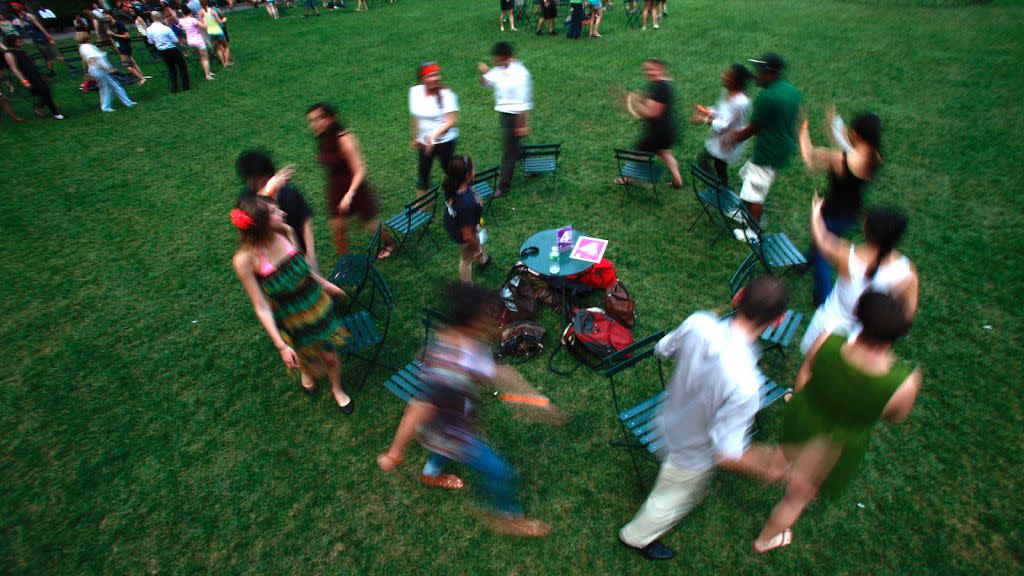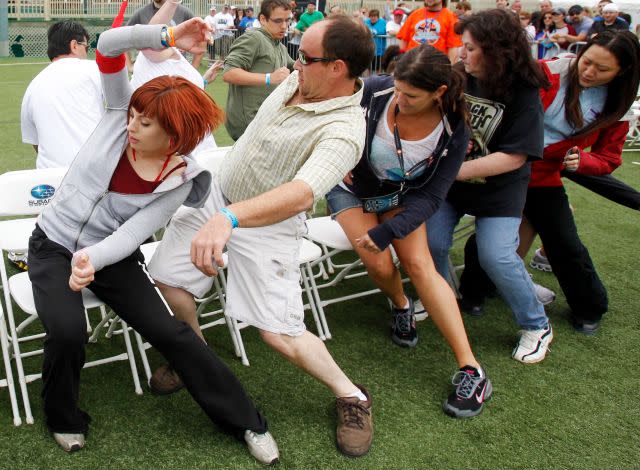How a game of musical chairs can help explain our broken economy

At the dawn of the Industrial Revolution, futurists predicted an imminent paradise of leisure thanks to new machines that could “do the work of a thousand men.” If productivity rises a thousand-fold, it stands to reason that eventually, we will have to work only one-thousandth as hard. Right?
Oops. In fact, hours worked have actually increased since the 1970s (not to mention commuting hours). In those days, a single wage-earner with a high-school education could support a family. Personal debt proportional to income was half of what it is today. Higher education was nearly free, public services robust, and health care cost less than half of present levels.
Why are we so much less wealthy? Is it that the machines have stopped working? Is it that technology has regressed? Is it that it takes more time to produce the same number of goods?
No. Something else is the matter. Something is creating artificial scarcity in the midst of tremendous objective abundance. Something is wrong with the means by which society allocates resources, coordinates labor, and distributes abundance. Something is wrong, in other words, with money.
What is money, anyway? At its core, money is a set of social agreements on how to count, store, and exchange value. These agreements generate artificial scarcity and require endless growth.
To see how, let’s look at a game of musical chairs.
How musical chairs can explain money
Imagine a game of musical chairs with, say, 100 people and 90 chairs. Everyone is up dancing around, and when the music stops, they all go for a chair. The 10 who don’t get a chair are out of the game, and—just to make it more interesting—let’s say that if you don’t get a chair, you lose your house, your kids go hungry, and you don’t get medical care.

Imagine the chaos. With so much at stake, everybody is elbowing and shoving each other to get a chair. Anyone who is nice or generous or altruistic—they’re out. They’re the losers. The most aggressive, dominant, and strongest people win, and unless you cultivate those competitive qualities, you’re out, too.
Sitting back watching this game is a politician, an economist, a biologist, and a priest. (Sounds like the start to a joke, right?)
The economist says, “There it is: human nature! Everyone is seeking to maximize their rational self interest.”
The biologist agrees, “Yes, and it stems from genetic programming to maximize reproductive self interest.”
The politician says, “Good thing I’m here to protect them from each other.”
And the priest says, “I’m going to go in there and try to convince them to be nicer to each other, be spiritual, and overcome their selfish nature.”
But is what they are seeing really human nature? Or is it a product of the rules of the game?
The money system works much like a game of musical chairs. That’s because money is created as interest-bearing debt, which means that there’s always more debt than there is money. We are therefore perpetually in competition for never enough money.
Let’s use another analogy to illustrate the global economy. Imagine there are 1,000 people in the world, and I am the only bank. I lend each of you $1 million at 7% interest, which means after 10 years, each person will have to pay me back $2 million.

Each person has $1 million and owes $2 million. How are you going to get that extra money? Well, if you are aggressive, smart, or lucky, you can make it from the other 999 people. However, no matter how hard everyone works, everyone is in competition with each other for never enough. There aren’t enough chairs. At least half of you will go bankrupt. $1 billion dollars have been created, but $2 billion are owed. Where’s the extra money going to come from?
In the real world, the story doesn’t end here. In fact, in 10 years most people can pay me back, because by then I will have lent enough new money into existence to cover the original loans, plus interest. You need a chair? I’ll give you one now—if you give me two the next time the music stops.
As the banker, I don’t lend new money to just anyone. I only lend if I think you’re going to pay me back. You must have a good business plan, good prospects, or something I know you can sell.

On the system level, this means that money creation can continue only as long as the economy is growing. If there aren’t at least as many “good business plans” as last time (to be precise, if the marginal efficiency of capital falls below zero), then money creation lags behind debt. Indebtedness rises. Then comes a vicious circle of defaults, falling demand, production cutbacks, unemployment, and so on in a classic crisis of capital.
Our current money system only works in the presence of growth. Without economic growth—without investment opportunities that will make more money back than was lent—there isn’t going to be investment. Money isn’t going to circulate in the economy. Therefore, governments left, right, and center all strive to generate growth. As growth has slowed in recent decades, we have seen how musical-chairs dynamics take over, in the form of concentration of wealth, austerity, and debt, debt, debt.
There is an alternative though. We can change the rules.
Changing the rules of the game
What would happen if you had 100 people and 100 chairs? And instead of one-bum-fits-all, maybe every chair is different, so people can swap for the chair they want. I have long legs, you have short legs. I like soft cushions, you like hard cushions. There will still be some trading and maybe some competition, but it won’t be a mathematical inevitability.
What system would have built-in abundance rather than built-in scarcity? How can we start choosing to work less, and devote more of our energies to the qualitative dimension of life, rather than to consume more? How can we transition to an ecological economy, one that doesn’t consume the planet?

Interest-bearing debt is the equivalent to the chair shortage in musical chairs. To reverse musical-chairs dynamics—to create more chairs—could we somehow reverse interest?
It’s actually not that hard. The theoretical basis for a negative-interest-based system was laid down in the early 20th century by German economist Silvio Gesell, elaborated on by American economist Irving Fisher in the 1930s, and even endorsed by John Maynard Keynes in his masterpiece The General Theory of Employment, Interest, and Money, where he called it “theoretically sound.”
The centerpiece of a negative-interest system is a liquidity fee on bank reserves. Imagine if the Federal Reserve, ECB, BOJ, and so on charged banks 5% on their accounts, amounting to a -5% interest rate rather than the 0%-1% that is normal today. System-wide, all interest rates would drop by about 5%. Checking accounts and demand deposits would bear a -4% or -5% interest rate. Treasury bonds would be at -2% or -3%. Mortgages would be at below zero. Investors, knowing that simply holding onto cash would entail 5% loss a year, would have incentive to lend at zero interest, allowing credit to circulate.
A shortage of chairs would no longer be written into the rules of the game.
Negative interest brings the following benefits. It:
Reverses the concentration of wealth, gradually redistributing it away from creditors and toward debtors
Allows credit and finance to operate smoothly without economic growth, consistent with an ecological economy
Reverses the discounting of future cash flows, encouraging long-term thinking and the production of durable, reusable, and repairable products
Discourages hoarding and increases the velocity of money
Functions as a universal wealth tax to replace other forms of taxation or fund universal basic income
Alleviates the crushing debt burden on consumers and nations by allowing zero-interest or negative-interest refinancing
Re-empowers the traditional tools of central banks by allowing them to breach the “zero lower bound”
It is this last point that has some central banks in Europe and Japan flirting with negative interest rates already, hoping to provide monetary stimulus when quantitative easing fails. Many sovereign bonds are also below zero, such as in Switzerland and Germany. A Danish bank recently has even begun offering mortgages at -0.4%.
Negative interest seems counterintuitive to anyone who has been immersed in the world of musical chairs. Why would anyone pay you to borrow their money? Why would someone let you have a chair for free? It only makes sense if “chairs” aren’t in artificially short supply.
The means it is within our grasp to play a new game, in which everyone has a seat at the circle. Suppose we are talking about bread, not money. If I have 100 loaves of bread, I would rather lend it out than keep it and watch it go stale. I would give everyone in the circle a loaf, telling them, “When you have an extra loaf of fresh bread and I need one, pay me back.” Because we all know it will go bad if not eaten soon, I don’t have the leverage to charge interest. Negative interest makes money more like bread, subjecting it to the universal law of decay that defines ecology. Ultimately, money that persists everlasting is inimical to an ecological economy.
But wouldn’t negative interest encourage speculation? Competitive devaluation? Inflation? Space does not allow a thorough treatment of these questions, except to mention that for the system to work, it would require some kind of graduated expiration date on cash, and probably some kind of Georgist tax on land. Also, money removed from the system via the liquidity fee would need to be reintroduced somehow, for example via universal basic income, to prevent deflation.
We will soon have ample opportunity to transition to a negative-interest system and give everyone a chair. The opportunity will come in the form of the next financial crisis when, instead of a creditors’ bailout like last time, we could implement a debtors’ bailout.
Like last time, the Fed will buy up distressed financial instruments, underwater mortgages, student loans, credit-card debt, and so on from the financial institutions that hold them. Unlike last time, it would then unilaterally cancel these debts, or at the very least reduce them and cut the interest rate to zero. Moreover, the new money it create through these asset purchases would be negative-interest money. The financial institutions would therefore remain solvent, but would not be rewarded for their misdeeds with free money that they could invest once more, risk-free, at positive interest rates to suck more wealth from the 99%.
The hopeless cycle of debt that oppresses people and nations alike is not a law of nature. It is a product of the rules of our game—of financial musical chairs. The means are within our grasp to play a new game, in which everyone has a seat at the circle.
This article was adapted from a talk Eisenstein gave at Bretton Woods 75, a conference that aimed to re-envision the global economic order.
Sign up for the Quartz Daily Brief, our free daily newsletter with the world’s most important and interesting news.
More stories from Quartz:


